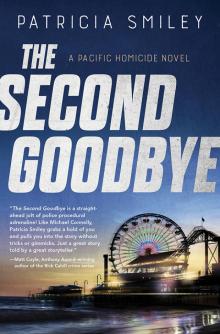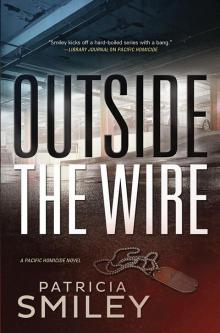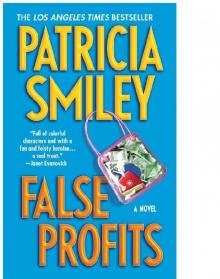- Home
- Patricia Smiley
Outside the Wire
Outside the Wire Read online
Copyright Information
Outside the Wire: A Pacific Homicide Novel © 2017 by Patricia Smiley.
All rights reserved. No part of this book may be used or reproduced in any matter whatsoever, including Internet usage, without written permission from Midnight Ink, except in the form of brief quotations embodied in critical articles and reviews.
As the purchaser of this ebook, you are granted the non-exclusive, non-transferable right to access and read the text of this ebook on screen. The text may not be otherwise reproduced, transmitted, downloaded, or recorded on any other storage device in any form or by any means.
Any unauthorized usage of the text without express written permission of the publisher is a violation of the author’s copyright and is illegal and punishable by law.
This is a work of fiction. Names, characters, places, and incidents are either the product of the author’s imagination or are used fictitiously, and any resemblance to actual persons living or dead, business establishments, events, or locales is entirely coincidental.
First e-book edition © 2017
E-book ISBN: 9780738753089
Book format by Bob Gaul
Cover design and photo by Ellen Lawson
Editing by Nicole Nugent
Midnight Ink is an imprint of Llewellyn Worldwide Ltd.
Library of Congress Cataloging-in-Publication Data Names: Smiley, Patricia, author.
Title: Outside the wire: a mystery / Patricia Smiley.
Description: First edition. | Woodbury, Minnesota: Midnight Ink, 2017. |
Series: A Pacific homicide mystery; #2
Identifiers: LCCN 2017021256 (print) | LCCN 2017025057 (ebook) | ISBN
9780738753089 (ebook) | ISBN 9780738752358 (print)
Subjects: | GSAFD: Mystery fiction.
Classification: LCC PS3619.M49 (ebook) | LCC PS3619.M49 O98 2017 (print) |
DDC 813/.6—dc23
LC record available at https://lccn.loc.gov/2017021256
Midnight Ink does not participate in, endorse, or have any authority or responsibility concerning private business arrangements between our authors and the public.
Any Internet references contained in this work are current at publication time, but the publisher cannot guarantee that a specific reference will continue or be maintained. Please refer to the publisher’s website for links to current author websites.
Midnight Ink
Llewellyn Worldwide Ltd.
2143 Wooddale Drive
Woodbury, MN 55125
www.midnightinkbooks.com
Manufactured in the United States of America
Acknowledgments
I’m grateful for the astute literary analysts who read my pages and provided insightful feedback, including Ramona Long; my wise and talented agent, Sandy Harding; and as always, the members of my beloved writing group—The Oxnardians. Thanks also to the team at Midnight Ink—Nicole Nugent, Katie Mickschl, and Terri Bischoff—and to fellow sailor Scott Jarema for suggesting the title. Much credit goes to Detective Michael D. DePasquale for setting me straight on the possibilities and limitations of police powers. I take full responsibility for occasionally ignoring his sage advice.
While researching this novel, I interviewed a number of veterans who shared their experiences from Vietnam and other wars. I offer my heartfelt appreciation for their candor and their sacrifice.
Dedicated to
My great uncle Julius, US Army 91st Infantry Division, who gave “the last full measure of devotion” in France on October 9, 1918
1
Davie Richards woke up at four a.m. as she had most mornings for the past few months: drenched in sweat, throat raw from crying out in her sleep. Flashbacks. The shrink had told her to expect them. A symptom of post-traumatic stress, he’d said. For what seemed like the millionth time, her mind played back the response.
“Soldiers in Kandahar have PTSD,” she’d said. “I don’t have PTSD.”
“Other traumas trigger symptoms. For example, people who’ve survived a car accident or an earthquake. They have nightmares and trouble sleeping, too.”
“I do not have PTSD.”
He had picked up his pen and scribbled some words on a note pad. She imagined it read something like Patient in denial and resistant to therapy. Prognosis hopeless.
She had told him early on how often she thought about the shooting—the sound of gunfire, the sight of blood pooled around the man’s head. True, she was going through a rough spell. For the past three months whenever she went to qualify at the firing range the smell of burnt gunpowder sent her heart racing. Loud noises made her flinch. But those reactions would fade over time. She just had to park the bad memories in an inaccessible compartment of her brain, same as she had always done.
Davie got out of bed, letting her coppery red hair tumble down her back. Her oversized white T-shirt had absorbed some of the sweat, but the sheets were damp. She examined them for a moment, wondering if she’d reached The Limit. It was a cop term for the number of dead people you could see before it was beyond your ability to cope. She’d seen her share of bodies during her nine-plus years as an LAPD patrol officer and in the past year as a detective. She’d known other Homicide detectives who’d investigated hundreds of murders and never reached The Limit, but none of them had killed two men in the line of duty. She had.
Sometimes she felt overwhelmed with guilt, thinking about the families that had been left to mourn, but she never questioned her decision to fire her weapon. The shootings were righteous. Her actions had saved innocent lives. But there was a price to pay for taking the life of another human being, and she was only beginning to understand that cost.
The department required everybody who’d been connected with an officer-involved shooting to be evaluated by a shrink. Following the first shooting, she’d been released after only one visit. Her relief was palpable, because extended therapy might have damaged her career. After the second shooting, she continued seeing the shrink because he hadn’t released her for duty right away … and because a part of her didn’t want him to.
Davie pulled the sheets away from the mattress before heading toward the kitchen to make coffee, hoping her workday would be uneventful.
2
Davie heard the sound of jet engines roaring overhead and the long, impatient honk of a car horn. Warm, stale air blasted through the open window of the detective car as she drove up the corkscrew ramp of the parking facility adjacent to Tom Bradley International Terminal at LAX. An hour after arriving at work, she and her partner, Det. Jason Vaughn, had been called out to investigate a body found on the second floor. Davie disliked the closed-in feeling of parking garages. Lately they made her feel claustrophobic.
Vaughn ended his phone conversation. “Communications Division didn’t get any calls about a disturbance before the body was found.”
“Probably no witnesses then. Just our luck.”
He looked at her and smiled. “Another opportunity to use our superpowers.”
Davie had known Vaughn since their academy days but had only worked with him for the past several months at Pacific Area Homicide. They didn’t always agree on how to approach the work, but they hashed out their differences without any permanent damage to the friendship.
After Davie parked, she stepped out of the car, inhaling the acrid odor of motor oil and tire rubber. Pacific patrol officers had already established the crime scene perimeter to protect any evidence and marked it off with yellow tape that read police line—do not cross. She instructed them to cordon off all entrances to the garage and list the make, model, and license plate
numbers of nearby vehicles. She also assigned one officer to maintain the crime scene log and another to canvass the area for witnesses.
Davie and Vaughn always followed the same routine. They studied the area from different angles and compared notes later, because the truth was, sometimes you couldn’t see the forest for the trees. Davie jotted down their arrival time and the weather conditions—57 degrees and overcast—and noted that the lights in the garage provided limited visibility.
Normally she and Vaughn agreed on a path that everyone would use to enter and exit the crime scene to keep contamination at a minimum, but she was annoyed to see their protocol had already been breached. An officer and a sergeant from the Airport Police had walked through the crime scene and were standing near the victim. Before approaching them, she made a sketch in her notebook, including the position of the parked cars relative to the body on the pavement. She was no artist, but the diagram had to be completed before calling in the criminalists. Sometimes things got moved or disturbed and she had to know exactly how the scene looked when she arrived.
The Airport Police had a stormy history with the LAPD, so when she introduced herself to the sergeant, she wasn’t surprised that his greeting was short and curt. The sergeant’s chin tilted upward in a gesture of defiance. “I called the coroner’s office. They’re on their way.”
Davie could almost feel her blood pressure spike, but she wasn’t going to give him the satisfaction of knowing that. What he’d done was improper and he knew it. This was Pacific Homicide’s crime scene, not his. The sergeant was just leg lifting, marking his territory.
No ambulance had been called to the scene, so it would be the coroner’s job to determine time of death and later to check the victim’s body for hair or fiber evidence. She had an hour to make the first call to the coroner’s office but that was only to give them a heads up about the body. The investigator wouldn’t respond to the scene until Davie called the second time, because once he arrived the corpse belonged to him. Between the two calls, detectives and criminalists had a chance to take photographs, collect fingerprints, and gather other evidence without having everybody and his brother tramping through the area.
Her tone was low but firm. “Stand down, sergeant, before you piss off the wrong people.”
The sergeant’s stony expression told her he was unmoved by her warning. “Just trying to speed things up.”
Vaughn shot him a hard stare as he pressed numbers on his cell keypad. “I’ll call Dr. Death. Tell him to put us on the list but not to roll out until we phone again.” He turned his back on the sergeant and walked a few feet away to talk in private.
Davie was petite—five-one, just over a hundred pounds. Men often used their bulk to intimidate her. It never worked. “We only have one chance at a crime scene. You screw that up and a killer goes free. You want that on your conscience?”
The sergeant glanced at the officer by his side and then answered in a matter-of-fact tone. “You’re preaching to the choir, Detective.”
Davie thought about pressing her point but suspected any attempt to change his attitude would be unproductive. Instead, she jotted down his name, serial number, and rank. “Who found the body?”
“A schoolteacher,” the sergeant said. “She came back from a wedding in Jerusalem. On her way to the car, she saw him slumped on the ground.” He pointed to the body lying by the trunk of a four-door Audi A6. “Over there.”
“Where’s the witness now?” Vaughn said.
Davie flinched at the sound of her partner’s voice. He’d obviously completed his call to the coroner’s office, but she hadn’t heard him creep up behind her.
“In the back of our patrol car,” the sergeant said. “She’s pretty freaked out.”
“I’ll grab the tape recorder from our Murder Kit and have a talk with her,” Vaughn said. “Maybe she saw the hit go down.”
As soon as her partner left, Davie squatted next to the victim. He was a white male with muscular arms and a trim waist. Judging by the wrinkles on his face and loose skin on his neck, she estimated his age as somewhere in his early sixties. Still, he looked unusually fit. None of his clothing was torn. There were no visible defensive wounds, so the victim hadn’t put up a fight. He was in the fetal position, which was often a reaction to pain. Rigor mortis hadn’t yet set in, so it was unlikely he’d been dead for long.
A pool of blood from a perforating bullet wound on the right front side of his skull had saturated the victim’s black leather jacket and white polo shirt. She was no forensics expert, but the shot looked like it had been taken at fairly close range. The neat hole on the back of his head was smaller, which told her the bullet entered from the front and exited in the back. She flashed back three months to the suspect she’d killed with a similar shot and then forced her eyes closed to keep the memory at bay.
When she opened them again, she saw that a dog tag, wound loosely with black electrician’s tape, was attached to a ball chain around the victim’s neck. The tag lay near his left ear. The placement seemed unnatural, as if it had been staged.
She glared at the sergeant. “Anybody touch the body before we got here?”
“I moved the dog tag, ma’am. I was hoping to identify him, but I gloved up first.”
Davie turned toward the voice. The name on the Airport Police uniform pocket read luna. The officer had wide-set eyes and full lips. Close-cropped hair made his ears look like wings. Stitch marks were still visible on a jagged scar that stretched from his right ear to his chin.
“Nobody touches the body until the coroner gets here,” she said, recording his name and serial number in her notes. “You should know that.”
The sergeant crossed his arms over his chest to convey his disapproval. “He told you, Detective. He didn’t touch the body.”
Luna’s expression was impassive. “I served two tours in Afghanistan, ma’am. Army infantry. I saw the dog tag. I thought he might be a bro.”
Davie studied Luna’s scar and wondered if it was a battle wound. Then she pointed to the victim. “This guy looks at least thirty years your senior. It seems unlikely he’s still on active duty.”
“That doesn’t matter. He’s still my bro.”
“How do you know he’s Army?”
Luna returned her stare without blinking. “You can tell by the dog tag. Each branch of the military uses different information. That’s why I know this guy was Army, like me.”
“Is that printed on the tag?” Luna shook his head, so Davie continued. “What else can you tell me about it?”
“It’s painted black. Since Vietnam, the Army requires soldiers who operate behind enemy lines to blacken all insignia.”
“You think he served in Vietnam?” she said.
“Hard to say, but the tag looks old. This one has a social security number on it. The Army doesn’t use those anymore.”
Davie sat on her heels next to the body for a closer look. “Why is it wrapped with tape?”
Luna hunkered down across from her and pointed. “See that plastic bumper around the tag? It’s called a silencer. It’s supposed to keep the tags from making noise when you’re on the move. Sometimes that isn’t enough. The enemy can still hear you coming. So, some guys tape the tags together to keep them from jangling.”
“You keep saying tags. I only see one.”
“There’s usually a second one attached by a short chain. When a soldier dies in battle, one tag is removed and taken back to headquarters. The other stays on the body for identification purposes.”
Davie pulled a pen from her notebook and slipped it inside the finger of a latex glove. She lifted the tape, exposing five lines of information stamped into the metal: woodrow, zeke c., followed by a social security number, o pos, and no rel pref. She assumed the last two lines represented his blood type and his religious preference—none.
“The tape looks
like it was torn,” Davie said. “The edges are still clean, so I’m guessing it was recent.”
“Yes, ma’am. That’s what I thought, too.”
“You think whoever tore the tape stole the second tag?”
“Could be.”
Davie rose to her feet. “You think the victim could still be on active duty?”
Luna stared at the body. “I doubt it. The Army makes you retire at sixty. He looks a few years older than that.”
“If he’s retired, why was he wearing dog tags?”
A haunted look settled on Luna’s expression as he stood to meet her gaze. “I don’t know, ma’am. Most retirees don’t wear their tags, but you get close to people when you’re in the military. Soldiers are trained to get everybody out alive. Sometimes you fail. The victim might be honoring a buddy who died in combat. It’s hard to explain to civilians. It’s a brotherhood stronger than anything, even family.”
Davie didn’t know what it was like to be a soldier, but she’d been a cop for almost ten years, so she understood the bonds between people who were responsible for keeping you safe. She made a 360-degree turn, studying the garage. The murder had been committed in a secluded area in the early morning hours when it was likely still dark and no one would be around. There was no place for the victim to escape an attacker unless he jumped two floors to the street. Robbery might have been the motive for the attack, but it seemed unusual that a killer would find value in old military ID tags. She would know more about what was missing when she searched the car.
A car-key remote lay near the body. It couldn’t be moved until it had been photographed, but Davie wanted to know if it belonged to the Audi. She gloved up, walked toward the car, and discovered that the driver’s side front door wasn’t locked. That told her the victim hadn’t had time to secure the car before he was killed. Since he fell near the trunk, he may have been heading to get his suitcase.
She made notes and then returned to the body. Without disturbing the position of the remote, she pressed the lock button. The Audi’s lights flashed. The victim had likely driven the car to the airport, but that couldn’t be confirmed until she ran the license plate. Once she viewed the garage surveillance footage, she hoped to see who fired the shot. She pressed the remote again to return the vehicle to its unlocked state.

 The Second Goodbye
The Second Goodbye Outside the Wire
Outside the Wire False Profits
False Profits Cover Your Assets
Cover Your Assets Pacific Homicide
Pacific Homicide Cool Cache
Cool Cache